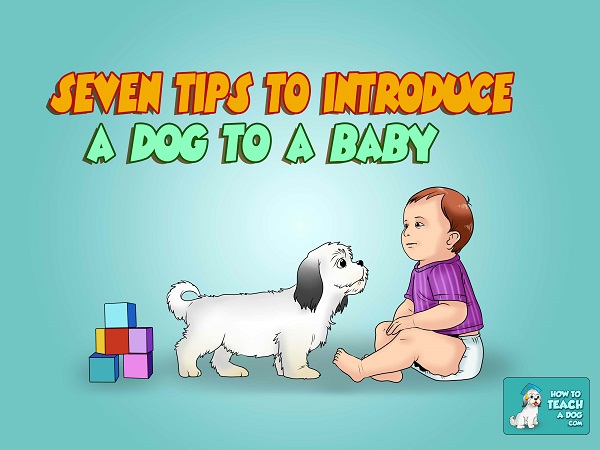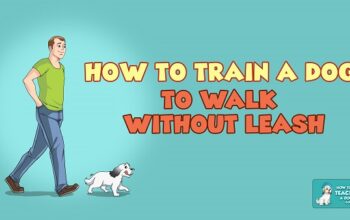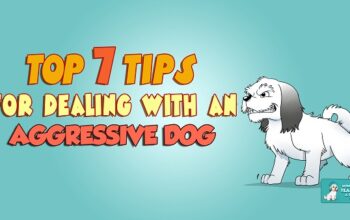
There isn’t much cuter than dogs and babies. There are pictures all over the internet of newborn with their canine family members. But there is a right way and a wrong way to prepare your dog for the new arrival. Here are seven tips for introducing a dog to a baby to make the introduction as smooth as possible.

1. Solve the behavior issues as soon as you get the news
Once the baby comes home, the family must focus on bonding with their infant, and there will be no time to work on training your dog. Get this done well in advance of your baby’s arrival. Don’t rely on your ability to manage the behaviors you don’t like. Management always fails. Doors get left open, food gets dropped, mistakes happen. If you have a resource guarder, find a positive reinforcement trainer and work with them right away.
2. Begin preparing your dog for changes early
Do not wait until the baby comes to make any changes that will be necessary in your dog’s world. If he sleeps with you or gets on the furniture, you might want to teach him to stay on the floor. Baby will now have those places in your world. Begin diminishing the time you spend with your dog. Train your dog to stay out of the nursery if he is accustomed to being allowed free run of the house. A new baby must be the priority, and your dog is going to lose out. It’s just a fact. If all the “bad stuff” happens when baby comes home, and the dog may decide that Baby is to blame, and not like her very much. Avoid this by setting the ground rules long before Baby arrives so your dog is used to the new routine.
Get your dog used to smells and sounds of Baby before she comes home. Bring things that smell like babies into your home before Baby arrives. Lotions, powders, wipes, etc. Buy a baby doll that cries, and place it in Baby’s room, or record the sounds and play them in the background of your dog’s life. Teach your dog where his special place in the home is, and teach him to go there when you ask.
3. On the day Baby comes home try to make it a low key event for all
When you get excited, your dog gets excited. And when your dog sees a wiggly, squeaky little creature he will probably get excited. Bring your baby into the house in her car seat, and rest her on a stable surface. Do not walk away. Don’t take Baby out of the carrier with the dog around. That will be way too much to ask your dog to ignore – dogs like to investigate novel things, and we do not want him to jump up to check Baby out.
4. Don’t try to show the dog the baby is “alpha” by playing keep away with Baby
This is just silly. Dogs are not trying to take over your household, and they are not going to believe that your infant is the pack leader. They aren’t stupid. If you are holding Baby and pushing your dog away all the time, your dog will decide that Baby is the reason he has lost access to his most valuable resource: YOU! Don’t give your dog a reason to dislike your child. Let your dog know that you are still there for him by letting him approach you, even when you have Baby, but hold Baby in a pillow or sit with your body between your dog and Baby so that there is always a physical barrier that just happens to be in the way.
5. Don’t put the baby on the floor with the dog!
Keeping your dog on the floor and the baby off the floor when the dog is loose is not about pack leadership. It’s about safety. It takes a split second for something bad to happen. This is just not safe. Please don’t do it!
6. Don’t kick your dog out of your life
A dog is a ten to twenty year commitment. But life in the back yard locked away from the family is no way for a dog to exist. They are social animals, and they need you. Dogs are a domesticated species. They have lost their instinct to survive without their humans. They feel physical and emotional pain. Make a point to set aside time for your dog every day to make sure they know they are still a part of your family.
7. Always have 100% AWAKE ADULT SUPERVISION, and pay attention to what your dog is trying to tell you!
You are going to be tired. What new parent isn’t? Don’t take a nap on the couch with the nursery door open and the dog loose in the house. It only takes a second for things to go terribly wrong. The best of dogs will bite under the right circumstances. Your dog is part of the family, but your dog is still an animal. He is going to behave according to his instincts, and sometimes those instincts can tell a dog to bite. When your dog is loose in the house with Baby do not leave Baby alone for any reason where your dog can get to her. And you know those “cute” pictures all over Facebook of babies and dogs? Most of them make trainers like me cringe. We hear all the time that a dog bite occurred “without warning”. But the dog was likely giving warning in his own way, and those warnings were just not seen by the parents. And most dog bites of children happen when the parent is IN THE ROOM. They just don’t know what to watch for. Pay attention to your dog’s body language. Watch for tongue flicking (dog licks his nose in a quick motion), whale eye (where you can see the whites of the eyes), panting when the dog is not hot, yawning, freezing or trying to avoid the situation, and of course, baring teeth, snapping, and growling. All of these are communication tools your dog uses to try and tell you he is in distress. Listen to him, if not for his sake, for the sake of your child. Don’t punish your dog for communicating, just make sure you remove your child and give the dog a little space. A chance to take a cute photo is not worth your child’s future!
There is nothing better for a child than growing up with a dog, but there are issues of safety that must be considered. If you have any concerns about your dog’s ability to adjust to having a new baby in your household consult a professional who can help you with the transition. You can never be too prepared when it comes to keeping your child (and your dog) safe.


